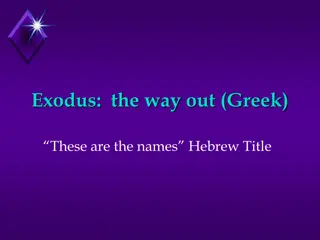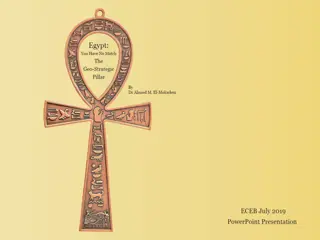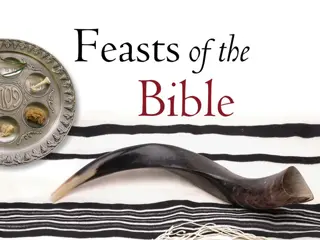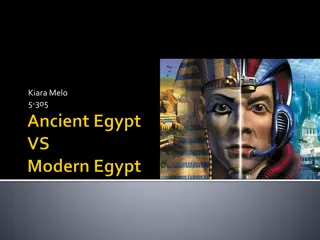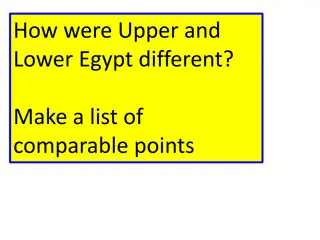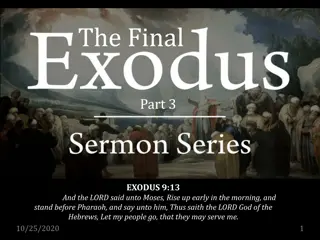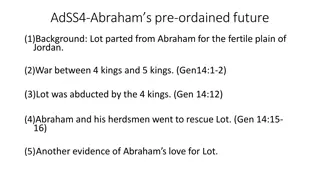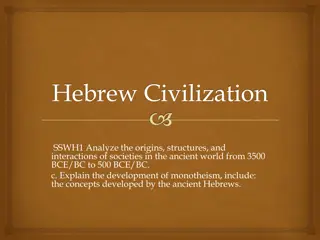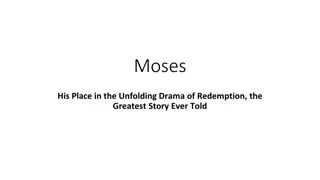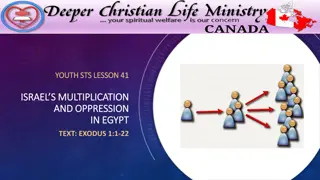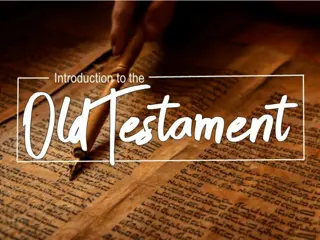Insights into the Exodus: Journey from Egypt to Canaan in Abib
Explore fascinating insights into the Exodus journey of the Hebrews from Egypt to Canaan in the month of Abib. Uncover historical details, including the 430-year Egyptian sojourn and the significance of locations like Rameses and Goshen. Delve into the proposed adjustments in Egyptian chronology, offering a fresh perspective on biblical events. Witness the rainy season in the Sinai Peninsula and discover the context surrounding this pivotal moment in history.
Download Presentation

Please find below an Image/Link to download the presentation.
The content on the website is provided AS IS for your information and personal use only. It may not be sold, licensed, or shared on other websites without obtaining consent from the author.If you encounter any issues during the download, it is possible that the publisher has removed the file from their server.
You are allowed to download the files provided on this website for personal or commercial use, subject to the condition that they are used lawfully. All files are the property of their respective owners.
The content on the website is provided AS IS for your information and personal use only. It may not be sold, licensed, or shared on other websites without obtaining consent from the author.
E N D
Presentation Transcript
This day came ye out in the month of Abib. Ex. 13:14 by Maralyn Dyck pmdyck@gmail.com
At the time of The Exodus the Hebrews had been in Egypt for 430 years. "Now the sojourning of the children of Israel, who dwelt in Egypt, was four hundred and thirty years." Ex. 12:40 If you accept the new Egyptian chronology, Neferhotep was Pharaoh. His body was never found! (At the bottom of the Red Sea with his army?) Egypt was conquered by an invading army without contest. Why? (Perhaps the army was at the bottom of the Red Sea?) A proposed adjustment in Egyptian chronology has provided all kinds of interesting evidence that the Israelites were in Egypt, that they were slaves, that the ten plagues did happen and more. Go to www.creationontheweb.com/content/view/1827 to read all about this in detail. The date the actual Exodus began was the 14th day of Abib (April). This day came ye out in the month of Abib." Ex. 13:4 9/4/2009 pmdyck@gmail.com 2
Sinai Desert in April - Abib 9/4/2009 pmdyck@gmail.com 3
This was the rainy season for the Sinai Peninsula, the only time of the year when the wadies would have plenty of water in them. This was the best time of year for desert grasses and plants as well. Back in those days the earth was not as dried out from the flood as it is now. The Philistines held the coastal route up into Canaan. The Amalekites, a nomadic shepherd tribe, lived in the wilderness areas or northern Sinai Peninsula and in the land below Moab. 9/4/2009 pmdyck@gmail.com 4
Rameses was the capital of Egypt, also known in history as Raamses or Zoan. It was a large coastal city and all of Pharaoh's business was conducted from Rameses. Rameses was one of two such storage-cities (Strong Cities or Garrison Cities) built for Pharaoh by the Hebrews. "Come on, let us deal wisely with them, lest they multiply and in the event of war, they also join themselves to those who hate us, and fight against us, and depart from the land. So they appointed taskmasters over them to afflict them with hard labor. And they built for Pharaoh storage cities, Pithom and Raamses." Ex. 1:10-11 These cities probably provided lodging and storage for all of Pharaoh's armies and their weaponry, which would account for their being called "Garrison Cities" in the New Jerusalem Bible. History mentions a third storage city at Heliopolis near Cairo. 9/4/2009 pmdyck@gmail.com 5
Goshen, where Jacob and his sons were settled when they first came to Egypt, was apparently known as the "field of Zoan," thus lying in the fertile delta area east of the Bubastic Branch of the Nile River. "...in the best of the land, in the land of Rameses, as Pharaoh had commanded." Gen. 47:11 It appears that Goshen extended south almost to Cairo by the time the Hebrews left Egypt in order to make room for their growing families and flocks. 9/4/2009 pmdyck@gmail.com 6
The Hebrews were to prepare unleavened bread to last for seven days as they were going to be travelling fast and would not have time to bake leavened bread. In their feast that they celebrated down through the years, they ate unleavened bread for seven days, representing the seven days that they had to eat unleavened bread on the Exodus journey. "And this day shall be unto you for a memorial. Seven days shall ye eat unleavened bread." Ex. 12:14-15 "And the people took their dough before it was leavened, their kneedingtroughs being bound up in their clothes upon their shoulders." Ex. 12:34 And they baked unleavened cakes of the dough which they brought forth out of Egypt, for it was not leavened; because they were thrust out of Egypt, and could not tarry, neither had they prepared for themselves any victual. Ex. 12:39 "...they borrowed of the Egyptians jewels of silver, and jewels of gold, and raiment: And the Lord gave the people favour in the sight of the Egyptians, so that they lent unto them such as they required." Ex.12:35-36 9/4/2009 pmdyck@gmail.com 7
The Egyptians still had a few mines in the Sinai Peninsula and they also had migdols located along the Suez Canal and the Aqaba Canal of the Red Sea to keep track of shipping and also to warn of approaching enemies. It is not known if these migdols were still operative at the time of the Exodus. If they were, Pharaoh could have kept track of the Israelites as they journeyed across the wilderness. These migdols communicated to each other by sending signals. Trade routes At this period in history there were two main trade routes to Canaan. The quickest and best route was north, but the Philistines were all through that area and "...God led them not through the way of the land of the Philistines, although that was near; for God said, Lest peradventure the people repent when they see war, and they return to Egypt." Ex. 13:17 The second route was south across the Sinai Peninsula to the Gulf of Aqaba and then turning north into Canaan. "But God led the people about, through the way of the wilderness of the Red Sea." Ex. 13:18 9/4/2009 pmdyck@gmail.com 8
During the 430 years that the Hebrews were in Egypt, an earlier Pharaoh, Amenemhati I, possibly built all or at least part of what has been called "The Wall of the Princes" and more recently "The Berlin Wall of Ancient Egypt." It is possible that the Hebrews worked on this wall, as well as building the two cities. This was a wall of defense that was built along the route of the lakes and canals connecting the Mediterranean with the Red Sea. The waterways were then filled with crocodiles. People coming and going from Egypt had to cross through the wall and over the waterways or canals by way of a large bridge. Their purpose was to keep out marauding tribes who liked to pasture their flocks in Egypt, plus it helped keep other tribes from conquering Egypt. It also served to keep the Israelites from leaving Egypt, even if they had wanted to do so. Along this wall migdols were built. These were fortification towers mainly for observation purposes. This wall was the end of Egypt's domain at this time in history. Once through the gates you were in the Wilderness of the Red Sea. 9/4/2009 pmdyck@gmail.com 9
There was a large migdol/fortress in the wall where a bridge crossed the canal. This was guarded by a legion of soldiers. No one could enter or leave Egypt without Pharaoh's permission. This fortress was called Sile or Tharu (and is believed to be the Biblical Succoth.) It was the staging area for assembling and outfitting Pharaoh's armies before going out to war. Moses would have been very familiar with this fort. As a son of Pharaoh for 40 years, he would have been very high in the army, possibly a general. He was well qualified for the task God had given him. When Pharaoh finally gave Israel permission for the Israelites to leave Egypt, Moses had them all gather together at Succoth (Tharu) and there he arranged them in military order by their tribes before beginning their exit from Egypt. "...and the sons of Israel went up harnessed (in martial array) out of the land of Egypt." Ex. 13:18 9/4/2009 pmdyck@gmail.com 10
Part of the Spice Route when travelling East 9/4/2009 pmdyck@gmail.com 11
"And the Lord was going before them in a pillar of cloud by day to lead them on the way, and in a pillar of fire by night to give them light, that they might travel by day and by night." Ex. 13:21 They were fleeing Egypt and they were in a hurry, afraid that Pharaoh might suddenly change his mind. They traveled day and night, stopping only long enough to eat and rest for a while. It can be assumed that it took seven days to reach Baalzephon, across the Red Sea, since they had to bake unleavened bread for seven days before they could rest and celebrate. The Lord later said, "...how I bare you on eagle's wings, and brought you unto myself." Ex. 19:4 "And I have led you forty years in the wilderness: your clothes are not waxen old upon you, and thy shoe is not waxen old upon they foot. " Deut. 29:5 In Abib or April the wadies would have had plenty of water in them. The Sinai Peninsula was not as dry then as it is now. 9/4/2009 pmdyck@gmail.com 12
Their first official encampment was at Etham at the edge of the Wilderness of Etham, which ran around the end of the Gulf of Aqaba. The previous days they had kept going, stopping just long enough to eat and rest. It was from Etham that God turned them south off the regular trade route and led them down a secondary trade route that ended at the Red Sea on the Gulf of Aqaba. This trade route had been used for shipping purposes. (This beach today is known as Nuweiba Beach and is a well-known tourist attraction!) "And the Lord spake unto Moses, saying, Speak unto the children of Israel, that they turn and encamp before Pihahiroth, between Migdol and the sea, over against Baalzephon: before it shall ye encamp by the sea. For Pharaoh will say of the children of Israel, They are entangled in the land, the wilderness hath shut them in. And I will harden Pharaoh's heart, that he shall follow after them; and I will be honored upon Pharaoh, and upon all his host; that the Egyptians may know that I am the Lord. And they did so." Ex. 14:2-4 9/4/2009 pmdyck@gmail.com 13
A Gulf of Aqaba part of the Red Sea B Mountains to the water s edge on both sides! C A large beach, big enough for all the Israelites and their flocks. D They exited from Wadi Watir onto the beach at this point. 9/4/2009 pmdyck@gmail.com 14
They turned south and south entered the wadi, the only entrance to Nuweiba Beach. The wadi was about18 miles long and would have had some water in it. It was the only way in to Pihahiroth. They emerged onto a large sandy beach which was more than adequate for 2-3 million people and their flocks to encamp overnight. The south end of the beach has mountains right to the water's edge. At the north end of the beach was Pihahiroth, a trading post, the remains of which are still standing today. Behind the beach in the mountains would have been the migdol upon a mountain top, that probably reported their location to Pharaoh. Directly across the water was Baalzephon, another trading post. The trading posts for shipping were probably no longer being used because there seemed to be no boats available for transferring the Hebrews across the Red Sea to Baalzephon. By the time the Israelites had reached this site they could hear the Egyptian army coming through the wadi behind them. There was no escape for they really were "entangled in the land" between the sea and the mountains. They panicked. "And they said unto Moses, Because there were no graves in Egypt, hast thou taken us away to die in the wilderness? Wherefore hast thou dealt thus with us, to carry us forth out of Egypt?" Ex. 14:11 9/4/2009 pmdyck@gmail.com 15
God had his own plans. The cloud that went before them went behind them and prevented the Egyptians from being able to come after them. They safely encamped that night right there by the sea. God gave Moses instructions. "And Moses stretched out his hand over the sea; and the Lord caused the sea to go back by a strong east wind all that night, and made the sea dry land, and the waters were divided. And the children of Israel went into the midst of the sea upon the dry ground; and the waters were a wall unto them on their right hand, and on their left." Ex. 14:21-22 The Hebrews walked across the Red Sea, a distance of about 8-10 miles. The sand bar, which is still there, deep in the water, is about mile wide. On either side of the sand bar the Red Sea is very deep. A satellite picture shows the water is much shallower there than anywhere else. Once the Israelites were across the sea, God removed the cloud from behind them and the Egyptian army came after them into the sea. God caused the wheels to fall off the chariots, making them hard to drag. As soon as all of Pharaoh's army was in the Red Sea, God caused the waters to go back into their place and the entire Egyptian army - chariots, cavalry and foot soldiers were ALL (including Pharaoh?) completely destroyed by the sea. Not one soldier survived. 9/4/2009 pmdyck@gmail.com 16
9/4/2009 pmdyck@gmail.com 17
Nuweiba Beach Above - In the foreground are the remains of an old trading post dating back to the days of King Solomon who had trading ships on the Sea of Aqaba Looking across the water towards Nuweiba Beach from the Arabian side of the Sea of Aqaba 9/4/2009 pmdyck@gmail.com 18
God "...troubled the host of the Egyptians, And took off their chariot wheels, that they drave them heavily...and the Lord overthrew the Egyptians in the midst of the sea...and the sea returned to his strength...there remained not so much as one of them." Ex. 14:24-28 The Israelites saw the Egyptians dead upon the seashore. They probably would have taken the time to rescue weapons from the Egyptians, maybe enough of them for most of their fighting men. Josephus says that besides the 600 chariots mentioned in the Bible that there were 50,000 cavalry and 200,000 infantry! At least some of this equipment would float ashore?! in the waves resulting from the passageway closing. The Israelites rested and rejoiced in their victory over the Egyptians. The people sang unto the Lord and Miriam and the women danced before the Lord, singing and playing their tambourines. 9/4/2009 pmdyck@gmail.com 19
Coral-encusted wheel? Notice metal rim and spokes in center of the picture a chariot wheel rim? Coral shape seen on the sand bar in the Sea of Aqaba perhaps two wheels and an axle from a chariot? 9/4/2009 pmdyck@gmail.com 20
They traveled from the Red Sea for three days in the wilderness and found no water. "So Moses brought Israel from the Red Sea, and they went out into the wilderness of Shur; and they went three days in the wilderness, and found no water." Ex. 15:22 NOTE: In Numbers 33:11 this same wilderness is called the wilderness of Etham. This is the name that matches the location of Etham as given on this map. Names given to places and regions very often change from one part of the Bible to another. Also, some names are used in more than one area. e.g. Succoth. There is a Succoth by the Jordan River as well as the one in Egypt. The Sinai Peninsula is called by various names throughout history. No one really knows for sure the boundaries or locations of the many wildernesses mentioned in the Bible, the wilderness of the Red Sea, the wilderness of Etham, the wilderness of Zin, the wilderness of Sin, the wilderness of Shur, etc., so I have placed them to match the Bible criteria in the most logical means possible. I guarantee nothing and neither can anyone else! 9/4/2009 pmdyck@gmail.com 21
The name is derived from the bitterness of the brackish water. Moses cast a tree into the waters, at God's command, and the waters were made sweet. They probably rested here for several days. "...and the Lord shewed him a tree, which when he had cast into the waters, the waters were made sweet..." Ex. 15:25 9/4/2009 pmdyck@gmail.com 22
Their next camp was at Elim. Elim was a lovely oasis that had twelves springs of water and seventy palm trees. They probably camped here for several days, as well, resting and gaining back their strength and energy before going on to Mount Sinai. "And they came to Elim, where were twelve wells of water, and threescore and ten palm trees: and they encamped there by the waters." Ex. 15:27 Point of interest Shepherds and cattlemen did not take their flocks down to the waters, as they would just muddy everything up. Rather, they carried water to their flocks and placed it in containers prepared for that purpose. In this way the waters in the desert areas were preserved for the next flocks to be brought that way. Some tribes used camels to transport this water back and forth, so it is a very possible likelihood that the Israelites did this also. Perhaps, during the days of rest mentioned above, Moses trained his 600,000 men in the arts of warfare, for a battle was coming up shortly and by then they knew how to fight. 9/4/2009 pmdyck@gmail.com 23
Current picture of Elim Still in existence but obviously not as big as it once was when the Israelites were there. Elim 9/4/2009 pmdyck@gmail.com 24
The Israelites arrived at this camp on the fifteenth day of the second month after their departing out of the land of Egypt. This meant that they had been travelling for a whole month. "And they took their journey from Elim, and all the congregation of the children of Israel came unto the wilderness of Sin, which is between Elim and Sinai, on the fifteenth day of the second month after their departing out of the land of Egypt." Ex 16:1 While at this encampment the Israelites complained about being hungry for bread and meat. They did not want to eat up their flocks and they were running out of grain. The Lord responded by supplying quail for one night that they could easily catch and also started the provision of manna which continued throughout their forty years in the wilderness. "And it came to pass, that at even the quails came up, and covered the camp: and in the morning the dew lay around the host...and it was like coriander seed, white; and the taste of it was like waters made with honey...and the children of Israel did eat manna forty years, until they came to a land inhabited...the borders of the land of Canaan. Ex. 16 9/4/2009 pmdyck@gmail.com 25
Nothing is known about this camp. However, its name would suggest some of the problems involved. The area was narrow for such a large company of people and animals and it must have been very hard keeping the herds separate at this stage. Perhaps overdriving would refer to having to push their herds along more rapidly then normal. N Theno further 9/4/2009 pmdyck@gmail.com 26
From the sounds of things the overdriving of the previous day has resulted in a very crowded situation at the next camp! Looking at the map you can see that the pass and desert area they are going through is very narrow and most likely does not provide much feed for the herds. Everyone, including the animals, would be feeling tense and frustrated about this time! 9/4/2009 pmdyck@gmail.com 27
When they reached this encampment, there was no water. God provided water. It is a good possibility that the rock that was split at this time has been found! The rock that has been discovered stands on the top of a 300 foot hill and the rock is very large. It stands about 50-60 feet tall. It has literally been split in half - the split is wide enough for a man to walk through (about 20inches). There is evidence that much water had poured from the area of this rock for a long period of time. There are dry water channels and even rocks made smooth like in a river bed. This rock is approximately 12 miles SW of Mount Sinai (Horeb). "...I will stand before thee there upon the rock in Horeb; and thou shalt smite the rock, and there shall come water out of it, that the people may drink." Ex. 17:6 There was still no peace for them, however, for the Amalekites to the north of them heard the Israelites were in Midian and could be heading their way. They came to Rephidim to fight against Israel. There own territory wasn't very much farther north and they wanted to stop them before they brought their flocks in to graze in their area. 9/4/2009 pmdyck@gmail.com 28
Rephidim 9/4/2009 pmdyck@gmail.com 29
The Amalekites were a tough nomadic shepherd tribe and pastured flocks all the way from below Moab on the east over to the land of the Philistines on the west and as far south as the head of the Gulf of Aqaba on the Red Sea. The land was not theirs but that was where they pastured their flocks. They pastured high in the hills during the dry seasons and down in the valleys during the rainy season. They were known to go out of their way to stop competitive tribes from entering their pasture lands. This was the Israelites first battle with the Amalekites, with more battles to come in the future. With God's help they defeated the Amalekites and drove them out. The next time we hear about the Amalekites they are in the western region just below Canaan, the promised land. "...And Joshua discomfited Amalek and his people with the edge of the sword...the Lord will have war with Amalek from generation to generation." Ex. 17 9/4/2009 pmdyck@gmail.com 30
Mt. Sinai at last! Notice the lonely little tree right on the top of this peak! Notice the blackened peak in the left background the peak God burned in His wrath when he talked to them! The split rock from which God supplied them with all their water during their stay at Mount Sinai! It is still there with dried up lakes around the bottom of it! 9/4/2009 pmdyck@gmail.com 31
Mount Sinai was their last encampment for a long period of time. Moses had brought the people to the "Mountain of God" as it is now known by today's local Bedouin tribes. This fulfilled the words that Moses received while at the burning bush at this same mountain 40 years earlier when God called him to deliver the Israelites. "Now Moses kept the flock of Jethro has father in law, the priest of Midian: and he led the flock to the backside of the desert, and came even to Horeb. When thou hast brought forth the people out of Egypt, ye shall serve God upon this mountain." Ex. 3 It was the third month by the time they reached Mount Sinai. Jethro heard that the Israelites had arrived at Mount Sinai and came to visit them there, bringing Moses his wife and two sons who had stayed behind in Midian when Moses went to get the Israelites. Jethro lived in Al-Bad, just twenty miles SW of Mount Sinai. Jethro spent a couple of days with Moses and gave him good advice on handling affairs of the Israelites and Moses did as he suggested. 9/4/2009 pmdyck@gmail.com 32
"And he said unto Moses, I thy father in law Jethro am come unto thee, and thy wife, and her two sons with her..." Ex. 18:6 "Hearken now unto my voice, I will give thee counsel, and God shall be with thee...so Moses hearkened to the voice of his father in law, and did all that he had said." Ex. 18:19 The Israelites stayed here before the mountain of God for a total of ten months. During that time many things happened, both good and bad. They built the Tabernacle in the Wilderness; God gave them the Ten Commandments and they were taught many things by God through Moses. Read Exodus 19 Numbers 11:32 for the events that happened during this time. 9/4/2009 pmdyck@gmail.com 33
9/4/2009 pmdyck@gmail.com 34
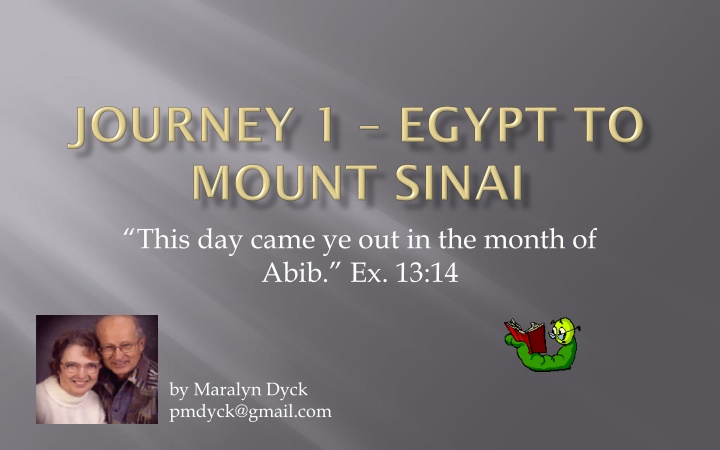

![[PDF⚡READ❤ONLINE] Tutankhamun's Trumpet: Ancient Egypt in 100 Objects from the](/thumb/20549/pdf-read-online-tutankhamun-s-trumpet-ancient-egypt-in-100-objects-from-the.jpg)
